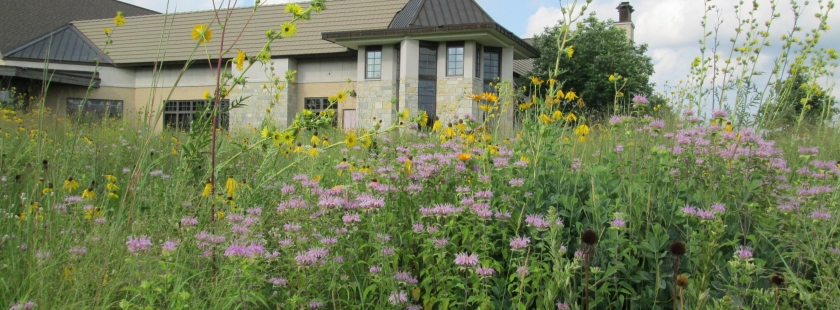
The Sun Prairie Public Library has a beautiful building rising from a carefully planted and maintained prairie ecosystem. Below are a few of the prairie plants that can be found in the library's prairie environment. Take a stroll outside sometime and see what you can find!
Blue Wild Indigo
|
Baptisia australisFound in dry-mesic prairies. Grows 3-5'. Trifoliate leaves with smooth edges. Blooms in June in shades of blue. Has large seed pods. About the name: "bapto" in Greek means "to dip." This plant has been used throughout history as a dye. It is also a well-known medicinal plant, used by American Indians to treat toothache. |
Butterfly Weed (Orange Milkweed)
|
Aesclepia tuberosaFound in dry or mesic prairies. Grows 10"-3'. Hairy stems, not milky, with clumps a foot or more tall. Has small flowers in blazing orange clumps in midsummer and a long taproot which makes it drought resistant. A perennial, it can be planted by seed. Spindle-shaped seedpods and smaller leaves than common milkweed. Attracts butterflies. Roots were once boiled as treatment for pleurisy, but the treatment was not found to be effective. |
Common Milkweed
|
Asclepias syricaA stout, 3-5 foot tall plant found in dry areas and roadsides. Milkweed has thick, milky sap if broken and small, fragrant flowers that grow in tennis-ball sized clusters during midsummer. Pointed, warty seed pods pop open when dried to release seeds attached to silky hairs which float like parachutes. Rubbery, oval leaves have mauve veins and are opposite. One plant commonly lives for several years, some as long as 25. Blooms in midsummer. Milkweed is the chief food for monarch larvae, making the caterpillars toxic to birds. Interesting details: the "silk" was used to stuff life-preservers in WWI; dried pods are used in dried winter flower arrangements; flower clusters, when tightly budded, can be eaten like broccoli. [contributed by Noah Potts] |
Compass Plant
|
Silphium laciniatumFound in mesic or wet-mesic prairie. Stands 6-12 feet, with very large, stiff, and deeply lobed leaves which alternate on stem at base of plant. The compass plant has long, woody roots that can reach up to 10 feet with yellow flowers atop tall, bristly stems. This plant has its name from the way its leaves move toward the sun. It was once thought to be a painkiller. [Contributed by Jordan McWilliams] |
Cream Wild Indigo |
Baptisia leucopheaFound in dry-mesic prairie. Grows up to three feet, but is normally one foot high. Grows in partial shade to full sun, with white or creamy blossoms which bloom in June. In fall, it produces dark, dry seed pods which rattle in the wind. |
Cup Plant |
Silphium perfoliatumTwo upper leaves surround the flowering stalks and form a cup which catches water. The leaves are rough and sandpapery, and coarsley toothed. Stands 4 to 8 feet tall. Interesting details: Rosin gum used to prevent vomiting and morning sickness, also to treat liver and spleen disorders. Used for face and body wash. Water could be drunk from the stem for good luck. |
Dense Blazing Star |
Liatris spicataFound in wet meadows and grows 2 to 4 feet tall. Has spikes with thistle-like blossoms, 5 to 9 florets on scaly bracts. Hairless stems with thin leaves up the stalk. The Dense Blazing Star is common in Wisconsin and blooms from top to bottom. |
Hard-leaved Goldenrod (also called Stiff or Rigid)
|
Solidago rigidaFound in dry thickets and sandy prairies, stands 1 to 5 feet tall. This goldenrod has a hairy stem with broad leaves, with the upper leaves being very rigid with large flowers.There are rigid oval leaves on the upper stem and deep, fibrous roots. Interesting details: There are many varieties of goldenrod and they are used medicinally and herbally. It has been used as an antiseptic, astringent, and as a remedy for hemorrhage. Sap from leaves has been used to make rubber. The leaves have been chewed for sore throats and the roots for toothache. It has also been used in tea. |
Ox-Eye Sunflower
|
Heliopsis heianthoidesLikes a very sunny habitat and will grow in any kind of soil. The plant is tall at 3 to 5 feet with mostly smooth leaves and stems. The leaves are in pairs. Yellow, daisy-like flowers bloom June to September. Although "Heli" means sun in Latin, these are not true sunflowers.[Contributed by Madelyn Pritzl] |
Purple Coneflower and Tall Purple Coneflower |
Echinancea purpuera and E. angustfoliaTwo very similar plants, although one has a taller cone. Found in dry, sunny prairies and grow 2 to 5 feet tall. Coneflowers have smooth stems and rough, scattered leaves. Very showy--orange, spiny cone-shaped center with 14 to 20 droopy purple petals. Now hybridized, often planted in roadside gardens. Strong seeder, good in bouquets and attracts butterflies. Interesting detail: Used treating sore teeth, burns, scratchy throats, and colds. [Contributed by Michael Lipps] |
[Prairie plant descriptions taken from "A Guide to Prairie Plants at the Sun Prairie Public Library," edited by Jacki Martindale. The full guide is available at the Information Desk.]